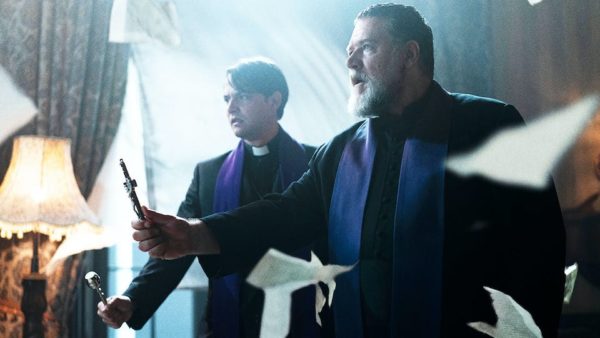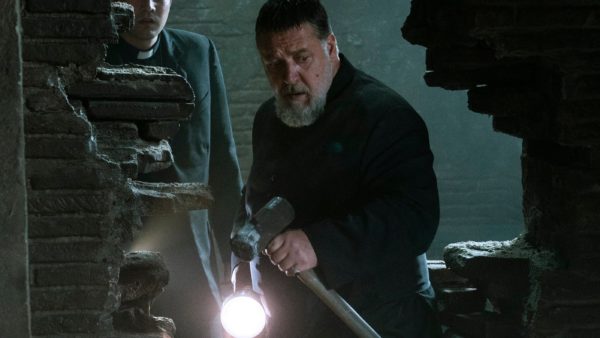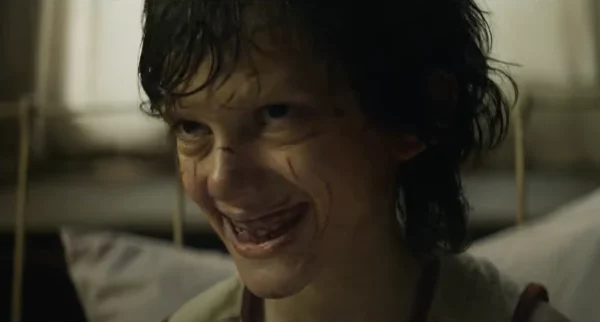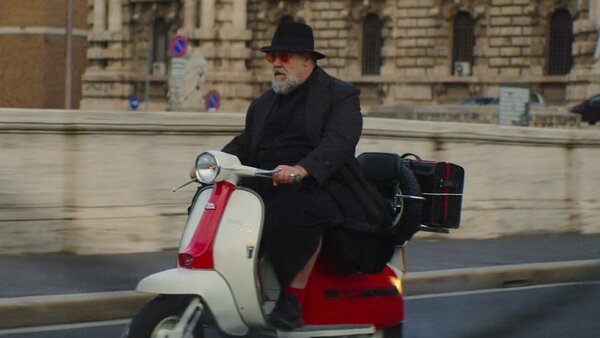
What more can you ask for from a possession film than an exorcist who rides a cute red and white Lambretta scooter?
Let’s get this on the table straight away: The Pope’s Exorcist is a very silly, albeit entertaining film.
Judging by the extras on the Blu release, the film’s protagonist – Father Gabriele Amorth – was quite the personality, so the character’s unusual, endearing quirks are in keeping with the real life figure. As embodied by star Russell Crowe, Amorth – and by extension The Pope’s Exorcist – has a surprising amount of camp appeal that nicely offsets its more mundane, traditional possession elements.
Screenwriters Michael Petroni and Evan Spiliotopoulos based the film on elements from two of Amorth’s books: 1990’s An Exorcist Tells His Story, as well as 1992’s An Exorcist: More Stories. (For added camp appeal, a post-script explains that the books are, in fact, good, which is an utterly hilarious beat to end the film on).

The film opens with an isolated case that introduces Amorth (Crowe) and his unusual approach to exorcisms. He arrives at a small house in Tropea, Italy on June 4, 1987, mocks a teenaged boy allegedly possessed by Satan, taunts the demon to possess a pig instead, and then orders the swine killed with a shotgun. It’s an extremely unorthodox resolution, which primes the audience to expect something slightly different from the usual possession fare.
While director Julius Avery winds up leaning into heavily trafficked visuals for the film’s ending (characters being thrown through the air, upside down crucifixes, and plenty of desperate praying), the playful subversions, principally embodied in Amorth’s character, help make a relatively stale horror subgenre feel a little more fresh.
A lot of the film’s success is courtesy of star Crowe, who isn’t afraid to go big and broad. The iffy Italian-tinged accent is a choice, but Amorth is such a *character* that The Pope’s Exorcist never feels too pretentious or self-serious. In addition to the scooter, Amorth drinks from a flask, yells at his superiors, and regularly cracks jokes during exorcisms (at one point, when he’s preparing Daniel Zovatto‘s Father Tomás Esquibel, Amorth helpfully clarifies that “The Devil does not like jokes.”)

If Amorth feels like a welcome breath of fresh air, the rest of the story surrounding him is pretty cookie cutter. Shortly after the events of the opening sequence, Amorth is assigned by the Pope (Franco Nero) to investigate strange events occurring at San Sebastian Abbey. It seems that Henry (Peter DeSouza-Feighoney), the pre-teen son of American widow Julia (Alex Essoe) and younger brother of Amy (Laurel Marsden), has been possessed, as evidenced by his mocking demonic voice (provided by Ralph Ineson) and his demands to speak with Amorth (in a hilarious scene, Tomás is literally thrown out of his room as Henry admonishes “Wrong fucking priest!”).
Unlike the events of the prologue, Henry’s case is severe. The child is self-harming and supernatural events around the house are escalating in typical, expected fashion (Sidebar: a pair of coordinated attacks on Julia and Amy in their respective bedrooms is good stuff).
In addition to this, the demon seemingly knows a great deal about Amorth: not only does the demon know his name, he knows Amorth’s past as an Italian partisan in the war, and even his failure to aid a mentally ill woman earlier in his career. It’s clear that this is no random possession; in fact, it’s part of a larger religious battle going back centuries that threatens the whole Catholic Church.

The creeping scope of the stakes, as well as the film’s extremely bombastic and FX heavy finale, is both appropriate and simultaneously ridiculous. This type of fire and brimstone narrative is all too familiar, as are the over the top pyrotechnics of the finale, which play out like The Conjuring sequel, only with a far more energetic – and welcome – lead performance.
All this to say: thank heaven for Crowe’s performance. His take on Amorth renders the film’s conventional and/or ridiculous elements more palatable. When the film requires Amorth to be paternal (to Tomás) or compassionate (to Julia and Amy), he is. But if the scene doesn’t require The Exorcist-level dread, however, Crowe is often loose, loud, and even jokey. The Aussie actor understands that this is a fun, pulpy exorcism movie (unlike, say, director Avery, who in the Blu’s extras seems convinced that he’s making a very scary film).
The Bottom Line: Crowe’s refreshing performance transforms a formulaic possession film into a fun romp. The Pope’s Exorcism is silly, dumb, and entertaining. 3.5/5
The Pope’s Exorcist is now available on 4K, Blu and VOD